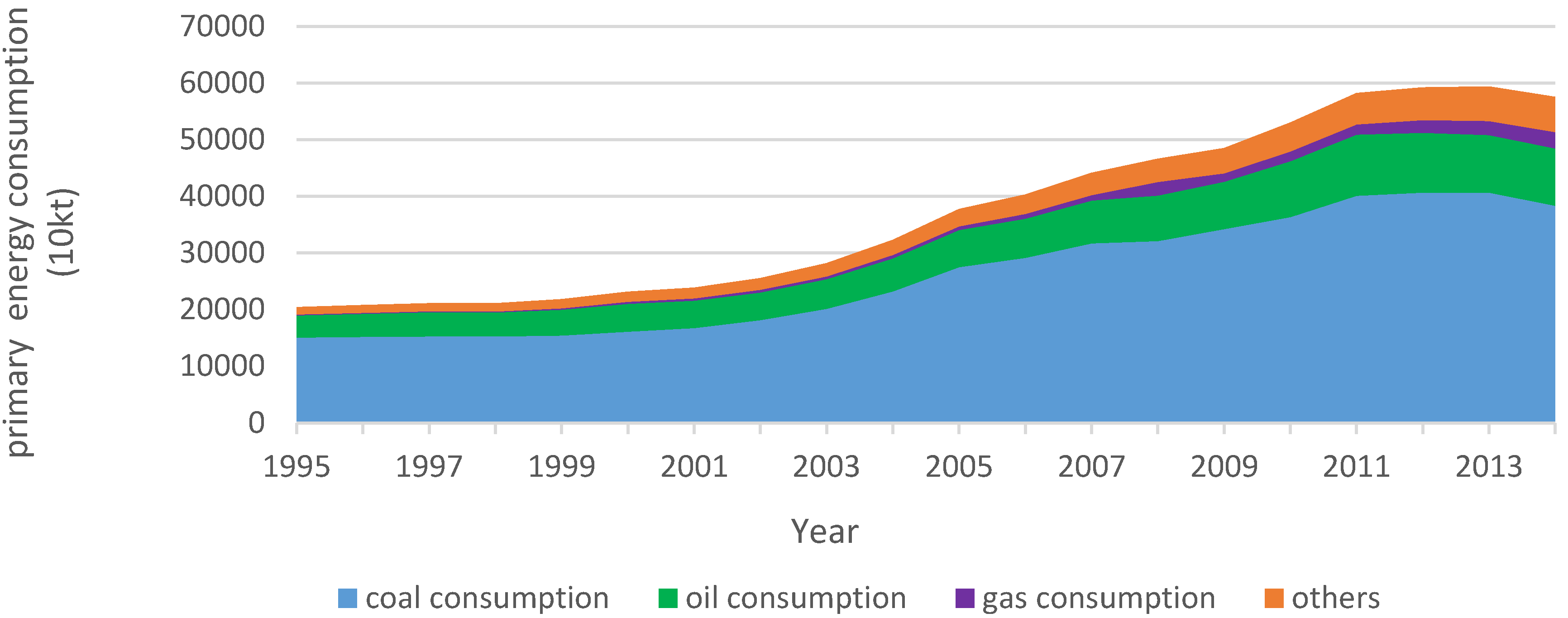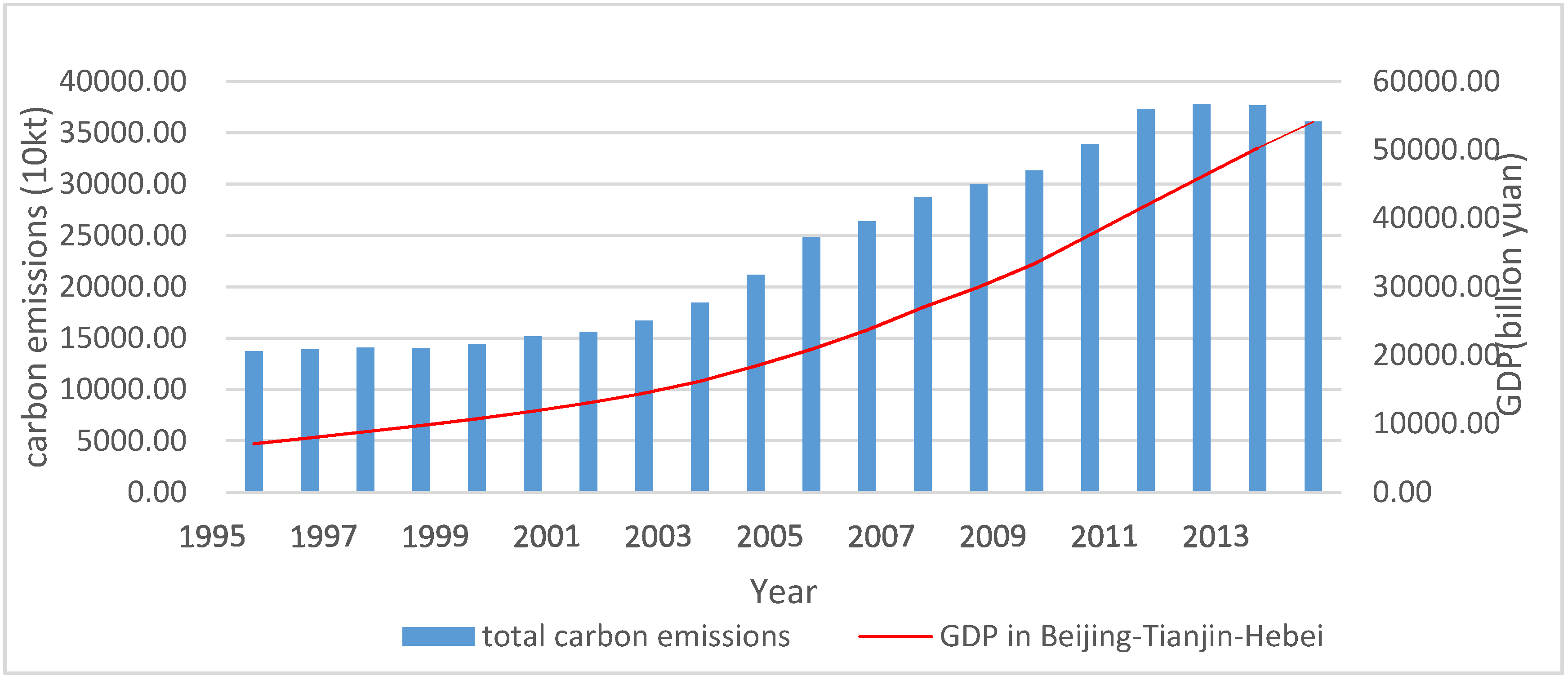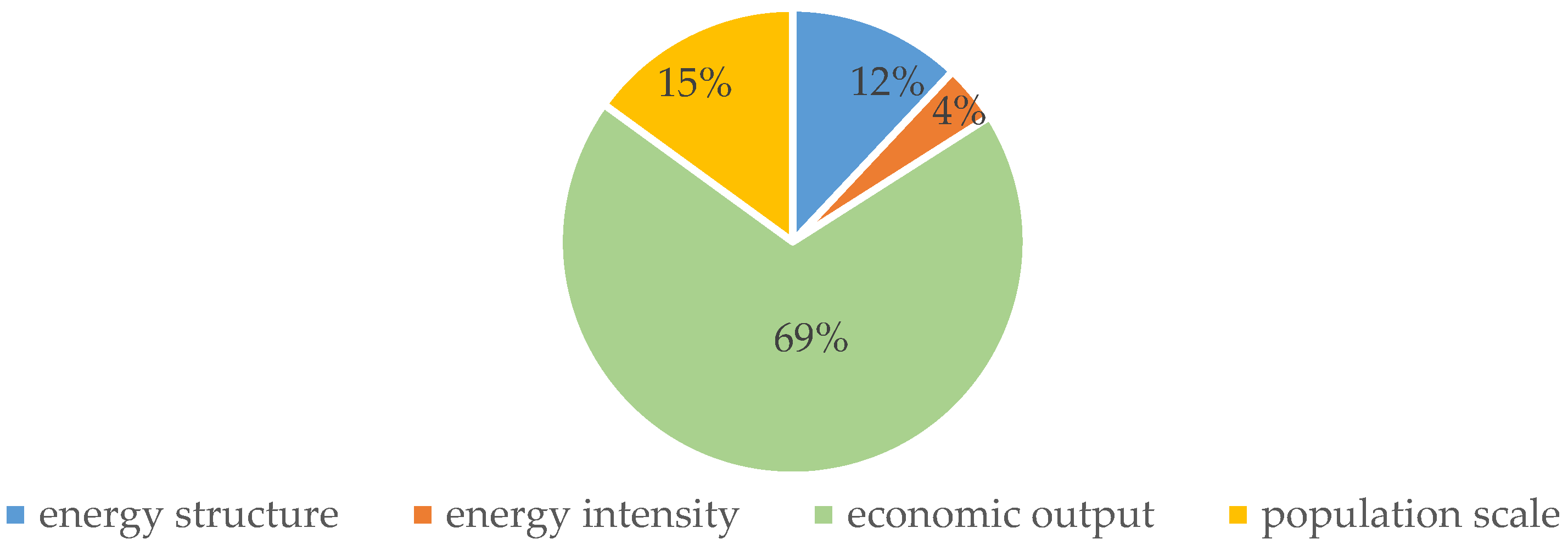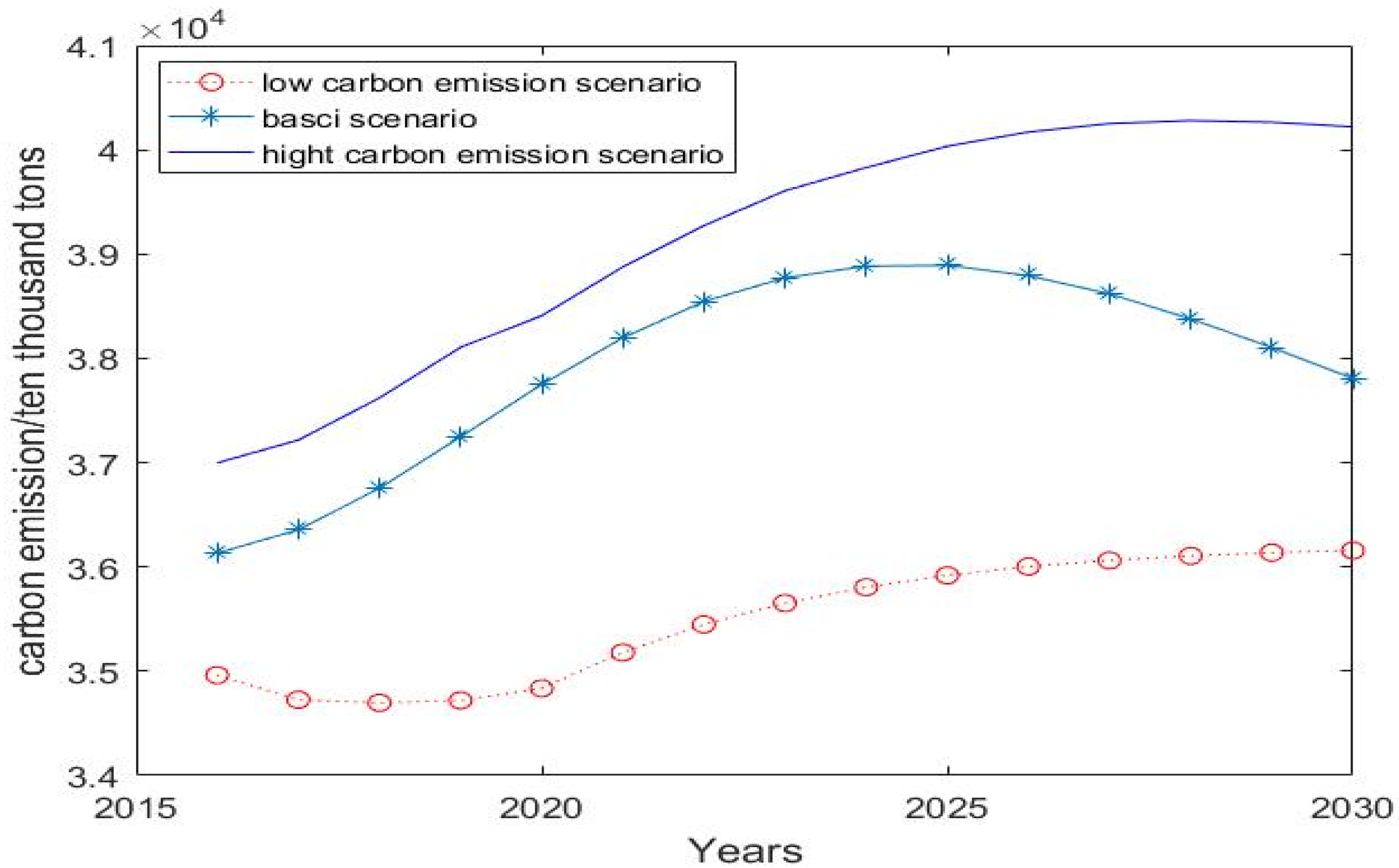Scenario Analysis of Carbon Emissions of Beijing-Tianjin-Hebei
Abstract
1. Introduction
2. Literature Review
3. Methods and Date Source
3.1. The Estimation of CO2
3.2. Generalized Fisher Index
3.3 Establishment of Predicting Method
3.3.1. Particle Swarm Optimization Algorithm(PSO)
3.3.2. IPSO-BP Neural Network Method
3.3.3. The Scenario Prediction Method
3.4. Date Source
4. Results and Discussion
4.1. Evolution of Primary Energy Consumption, Carbon Emissions, and GDP
4.2. Generalized Fisher Index Results
4.2.1. Energy Structure Effect
4.2.2. Energy Intensity Effect
4.2.3. Economic Output Effect
4.2.4. Population Scale Effect
4.3. The Inspection Results of IPSO-BP Neural Network Model
4.4. The Results of Scenario Prediction
4.4.1. Scenario Analysis Results for Influencing Factors
4.4.2. Scenario Prediction Results
5. Conclusions
- (1)
- Results reveal that energy consumption structure was developing toward benign direction in Beijing-Tianjin-Hebei region. Considering a strong correlation between the economic growth and carbon emissions from energy consumption, it is conducive to inhibit the increment of carbon emissions to some extent by reducing economic growth appropriately.
- (2)
- Over the study period, the effect of four driving factors on carbon emissions were different both in magnitude and in direction. The factors that drive the growth of carbon emissions from energy consumption in the Beijing-Tianjin-Hebei region were economic output and population scale, and the cumulative effect values were 5.9105 and 1.3009. Meanwhile, the contribution rates were 69% and 15%. On the contrary, the factors that mainly inhibited the carbon emissions were energy structure and energy intensity. The cumulative effect values were 0.3543 and 0.9813, and the contribution rates were 4% and 12%, respectively.
- (3)
- The predicted carbon emissions in high carbon scenario during 2015–2030 were the highest, followed by the basic scenario and low carbon scenarios. In the high carbon scenario, the carbon emissions will peak in 2028, which will be 40,280 million tons. In basic scenario, the carbon emissions will peak around 2025. In low carbon scenario, the carbon emissions will have a decline stage between 2015 and 2018, with an annual decline rate of 0.38%, and then the carbon emissions will be in the ascending phase during 2019–2030.
Author Contributions
Acknowledgments
Conflicts of Interest
References
- United Nations Framework Convention on Climate Change—The Paris Agreement. Available online: https://baike.sogou.com/v113787401.htm?fromTitle (accessed on 12 December 2015).
- National Bureau of Statistics of the People’s Republic of China. Available online: http://www.stats.gov.cn/tjsj/ndsj/2017/indexch.htm (accessed on 13 October 2017).
- Regional Planning for the Beijing-Tianjin-Hebei Metropolitan Area. Available online: https://baike.sogou.com/v71645024.htm (accessed on 5 August 2010).
- National Development and Reform Commission (NDRC). Available online: http://www.ndrc.gov.cn/ (accessed on 8 December 2015).
- The CPC Central Committee’s Proposal to Formulate the 11th Five-Year Plan for National Economic and Social Development. Available online: http://www.360doc.com/content/16/0308/21/19096873_540601354.shtml (accessed on 14 March 2006).
- The CPC Central Committee’s Proposal to Formulate the 12th Five-Year Plan for National Economic and Social Development. Available online: http://news.hexun.com/2010/5yearplan/index.html (accessed on 18 May 2012).
- Cheng, X.; Fan, L.; Wang, J. Can Energy Structure Optimization, Industrial Structure Changes, Technological Improvements, and Central and Local Governance Effectively Reduce Atmospheric Pollution in the Beijing-Tianjin-Hebei Area in China? Sustainability 2018, 10, 644. [Google Scholar] [CrossRef]
- Wang, L.; Zhang, F.; Pilot, E.; Yu, J.; Nie, C.; Holdaway, J.; Yang, L.; Li, Y.; Wang, W.; Vardoulakis, S.; et al. Taking Action on Air Pollution Control in the Beijing-Tianjin-Hebei (BTH) Region: Progress, Challenges and Opportunities. Int. J. Environ. Res. Public Health 2018, 15, 306. [Google Scholar] [CrossRef] [PubMed]
- Cai, B.; Li, W.; Dhakal, S.; Wang, J. Source data supported high resolution carbon emissions inventory for urban areas of the Beijing-Tianjin-Hebei region: Spatial patterns, decomposition and policy implications. J. Environ. Manag. 2018, 206, 786–799. [Google Scholar] [CrossRef] [PubMed]
- Li, J. Scenario analysis of tourism’s water footprint for China’s Beijing-Tianjin-Hebei region in 2020: Implications for water policy. J. Sustain. Tour. 2018, 26, 127–145. [Google Scholar] [CrossRef]
- Li, J.; Xiang, Y.; Jia, H.; Chen, L. Analysis of Total Factor Energy Efficiency and Its Influencing Factors on Key Energy-Intensive Industries in the Beijing-Tianjin-Hebei Region. Sustainability 2018, 10, 111. [Google Scholar] [CrossRef]
- Qi, J.; Zheng, B.; Li, M.; Yu, F.; Chen, C.; Liu, F.; Zhou, X.; Yuan, J.; Zhang, Q.; He, K. A high-resolution air pollutants emission inventory in 2013 for the Beijing-Tianjin-Hebei region, China. Atmos. Environ. 2017, 170, 156–168. [Google Scholar] [CrossRef]
- Can, W.; Jining, C.; Ji, Z. Decomposition of energy-related CO2 emission in China: 1957–2000. Energy 2005, 30, 73–83. [Google Scholar]
- Salim, R.; Yao, Y.; Chen, G.; Zhang, L. Can foreign direct investment harness energy consumption in China? A time series investigation. Energy Econ. 2017, 66, 43–53. [Google Scholar] [CrossRef]
- Yan, Q.; Yin, J.; Baležentis, T.; Makutėnienė, D.; Štreimikienė, D. Energy-related GHG emission in agriculture of the European countries: An application of the Generalized Divisia Index. J. Clean. Prod. 2017, 164, 686–694. [Google Scholar] [CrossRef]
- Zhou, X.; Zhang, J.; Li, J. Industrial structural transformation and carbon dioxide emissions in China. Energy Policy 2013, 57, 43–51. [Google Scholar] [CrossRef]
- Bhattacharya, M.; Paramati, S.R.; Ozturk, I.; Bhattacharya, S. The effect of renewable energy consumption on economic growth: Evidence from top 38 countries. Appl. Energy 2016, 162, 733–741. [Google Scholar] [CrossRef]
- Zhang, L. Correcting the uneven burden sharing of emission reduction across provinces in China. Energy Econ. 2017, 64, 335–345. [Google Scholar] [CrossRef]
- Chen, J.D.; Cheng, S.L.; Nikic, V.; Songm, M.L. Quo Vadis? Major Players in Global Coal Consumption and Emissions Reduction. Transform. Bus. Econ. 2018, 17, 112–132. [Google Scholar]
- Sheinbaum, C.; Ruíz, B.J.; Ozawa, L. Energy consumption and related CO2 emissions in five Latin American countries: Changes from 1990 to 2006 and perspectives. Energy 2011, 36, 3629–3638. [Google Scholar] [CrossRef]
- Lin, B.; Du, K. Decomposing energy intensity change: A combination of index decomposition analysis and production-theoretical decomposition analysis. Appl. Energy 2014, 129, 158–165. [Google Scholar] [CrossRef]
- Hatzigeorgiou, E.; Polatidis, H.; Haralambopoulos, D. CO2 emissions in Greece for 1990–2002: A decomposition analysis and comparison of results using the Arithmetic Mean Divisia Index and Logarithmic Mean Divisia Index techniques. Energy 2008, 33, 492–499. [Google Scholar] [CrossRef]
- Ang, B.W. Decomposition analysis for policymaking in energy: Which is the preferred method? Energy Policy 2004, 32, 1131–1139. [Google Scholar] [CrossRef]
- Akpan, U.S.; Green, O.A.; Bhattacharyya, S.; Isihak, S. Effect of Technology Change on CO2 Emissions in Japan’s Industrial Sectors in the Period 1995–2005: An Input-Output Structural Decomposition Analysis. Environ. Resour. Econ. 2015, 61, 165–189. [Google Scholar] [CrossRef]
- Croner, D.; Frankovic, I. A Structural Decomposition Analysis of Global and National Energy Intensity Trends. Energy J. 2018, 39, 103–122. [Google Scholar]
- Su, B.; Ang, B.W. Multi-region comparisons of emission performance: The structural decomposition analysis approach. Ecol. Ind. 2016, 67, 78–87. [Google Scholar] [CrossRef]
- Su, B.; Ang, B.W. Attribution of changes in the generalized Fisher index with application to embodied emission studies. Energy 2014, 69, 778–786. [Google Scholar] [CrossRef]
- Wang, H.; Ang, B.W.; Su, B. Multiplicative structural decomposition analysis of energy and emission intensities: Some methodological issues. Energy 2017, 123, 47–63. [Google Scholar] [CrossRef]
- Cansino, J.M.; Román, R.; Ordóñez, M. Main drivers of changes in CO2 emissions in the Spanish economy: A structural decomposition analysis. Energy Policy 2016, 89, 150–159. [Google Scholar] [CrossRef]
- Koppány, K. Estimating growth contributions by structural decomposition of input-output tables. Acta Oecon. 2018, 67, 605–642. [Google Scholar] [CrossRef]
- Román-Collado, R.; Colinet, M.J. Is energy efficiency a driver or an inhibitor of energy consumption changes in Spain? Two decomposition approaches. Energy Policy 2018, 115, 409–417. [Google Scholar] [CrossRef]
- Jimenez, R.; Mercado, J. Energy intensity: A decomposition and counterfactual exercise for Latin American countries. Energy Econ. 2014, 42, 161–174. [Google Scholar] [CrossRef]
- Xu, X.Y.; Ang, B.W. Multilevel index decomposition analysis: Approaches and application. Energy Econ. 2014, 44, 375–382. [Google Scholar] [CrossRef]
- Kaivo-oja, J.; Luukkanen, J.; Panula-Ontto, J.; Vehmas, J.; Chen, Y.; Mikkonen, S.; Auffermann, B. Are structural change and modernisation leading to convergence in the CO2 economy? Decomposition analysis of China, EU and USA. Energy 2014, 72, 115–125. [Google Scholar] [CrossRef]
- Román, R.; Cansino, J.M.; Rodas, J.A. Analysis of the main drivers of CO2 emissions changes in Colombia (1990–2012) and its political implications. Renew. Energy 2018, 116, 402–411. [Google Scholar] [CrossRef]
- Winyuchakrit, P.; Limmeechokchai, B. Trends of energy intensity and CO2 emissions in the Thai industrial sector: The decomposition analysis. Energy Sources Part B Econ. Plan. Policy 2016, 11, 504–510. [Google Scholar] [CrossRef]
- Chen, B.; Li, J.S.; Zhou, S.L.; Yang, Q.; Chen, G.Q. GHG emissions embodied in Macao’s internal energy consumption and external trade: Driving forces via decomposition analysis. Renew. Sustain. Energy Rev. 2018, 82, 4100–4106. [Google Scholar] [CrossRef]
- Torrie, R.D.; Stone, C.; Layzell, D.B. Understanding energy systems change in Canada: 1. Decomposition of total energy intensity. Energy Econ. 2016, 56, 101–106. [Google Scholar] [CrossRef]
- Xu, J.H.; Fleiter, T.; Eichhammer, W.; Fan, Y. Energy consumption and CO2 emissions in China’s cement industry: A perspective from LMDI decomposition analysis. Energy Policy 2012, 50, 821–832. [Google Scholar] [CrossRef]
- Xu, S.C.; He, Z.X.; Long, R.Y. Factors that influence carbon emissions due to energy consumption in China: Decomposition analysis using LMDI. Appl. Energy 2014, 127, 182–193. [Google Scholar] [CrossRef]
- Fang, D.; Zhang, X.; Yu, Q.; Jin, T.C.; Tian, L. A novel method for carbon dioxide emission forecasting based on improved Gaussian processes regression. J. Clean. Prod. 2018, 173, 143–150. [Google Scholar] [CrossRef]
- Sun, W.; Xu, Y. Using a back propagation neural network based on improved particle swarm optimization to study the influential factors of carbon dioxide emissions in Hebei Province, China. J. Clean. Prod. 2016, 112, 1282–1291. [Google Scholar] [CrossRef]
- Marjanović, V.; Milovančević, M.; Mladenović, I. Prediction of GDP growth rate based on carbon dioxide (CO2) emissions. J. CO2 Utilizat. 2016, 16, 212–217. [Google Scholar] [CrossRef]
- Ito, K. CO2 emissions, renewable and non-renewable energy consumption, and economic growth: Evidence from panel data for developing countries. Int. Econ. 2017, 151, 1–6. [Google Scholar] [CrossRef]
- Zoundi, Z. CO2 emissions, renewable energy and the Environmental Kuznets Curve, a panel cointegration approach. Renew. Sustain. Energy Rev. 2017, 72, 1067–1075. [Google Scholar] [CrossRef]
- Mrabet, Z.; Alsamara, M. Testing the Kuznets Curve hypothesis for Qatar: A comparison between carbon dioxide and ecological footprint. Renew. Sustain. Energy Rev. 2017, 70, 1366–1375. [Google Scholar] [CrossRef]
- Deviren, S.A.; Deviren, B. The relationship between carbon dioxide emission and economic growth: Hierarchical structure methods. Physica A 2016, 451, 429–439. [Google Scholar] [CrossRef]
- Mladenović, I.; Sokolov-Mladenović, S.; Milovančević, M.; Marković, D.; Simeunović, N. Management and estimation of thermal comfort, carbon dioxide emission and economic growth by support vector machine. Renew. Sustain. Energy Rev. 2016, 64, 466–476. [Google Scholar] [CrossRef]
- De Boer, P. Generalized Fisher index or Siegel–Shapley decomposition? Energy Econ. 2009, 31, 810–814. [Google Scholar] [CrossRef]
- Ang, B.W.; Liu, F.L.; Chung, H.S. A generalized Fisher index approach to energy decomposition analysis. Energy Econ. 2004, 26, 757–763. [Google Scholar] [CrossRef]
- IPCC (Intergovernmental Panel on Climate Change). 2006 IPCC Guidelines for National Greenhouse Gas Inventories; Eggleston, H.S., Buendia, L., Miwa, K., Ngara, T., Tanabe, K., Eds.; Prepared by the National Greenhouse Gas Inventories Programme; IGES: Hayama, Japan, 2006. [Google Scholar]
- Kaya, Y. Impact of Carbon Dioxide Emission Control on GNP Growth: Interpretation of Proposed Scenarios; Paper presented at the IPCC Energy and Industry Subgroup; Response Strategies Working Group: Paris, France, 1990. [Google Scholar]
- FallahHoseini, M.; Rafeh, R. Proposing a centralized algorithm to minimize message broadcasting energy in wireless sensor networks using directional antennas. Appl. Soft Comput. 2018, 64, 272–281. [Google Scholar] [CrossRef]
- Vinita, J.; Punam, B. An improved hybrid ant particle optimization (IHAPO) algorithm for reducing travel time in VANETs. Appl. Soft Comput. 2018, 64, 526–535. [Google Scholar]
- Yin, Y.; Mizokami, S.; Aikawa, K. Compact development and energy consumption: Scenario analysis of urban structures based on behavior simulation. Appl. Energy 2015, 159, 449–457. [Google Scholar] [CrossRef]
- Wen, L.; Liu, Y. The Peak Value of Carbon Emissions in the Beijing-Tianjin-Hebei Region Based on the STIRPAT Model and Scenario Design. Pol. J. Environ. Stud. 2016, 25, 823–834. [Google Scholar]





| Author(s) | Methodologies | Factors |
|---|---|---|
| [25] | Structural decomposition analysis (SDA) | structural change, technological improvements |
| [26] | Structural decomposition analysis (SDA) | GDP, Aggregate carbon intensity |
| [27] | Structural decomposition analysis (SDA) Generalized Fisher index(GFI) | Population, GDP, energy intensity |
| [28] | Structural decomposition analysis (SDA) Multiplicative decomposition | Total ratio changes, Emission intensity effect, Leontief structure effect, Domestic export effect |
| [29] | Structural decomposition analysis (SDA) | carbonization, energy intensity, technology, structural demand, consumption pattern and scale. |
| [30] | Structural decomposition analysis (SDA) Input-Output model | GDP, Population, energy intensity |
| [31] | Structural decomposition analysis (SDA) Index decomposition analysis (IDA) | energy intensity effect, Leontief effect, structure effect, affluence effect, population |
| [32] | Index decomposition analysis (IDA) | per capital income, energy prices, population growth, fossil fuel energy consumption, the investment capital ratio, country fixed effect |
| [33] | Index decomposition analysis (IDA) | activity effect, structure effect, sub-structure effect, intensity effect |
| [34] | index decomposition analysis (IDA) Advanced sustainability analysis | total primary energy supply, final energy consumption, GDP, population |
| [35] | Index Decomposition Analysis-Logarithmic Mean Divisia Index (IDA-LMDI) | carbonization, the substitution of fossil fuels, the penetration of renewable energy, energy intensity, wealth and population |
| [36] | Logarithmic Mean Divisia Index (LMDI) | activity, structural, energy intensity, fuel share, and emission effects |
| [37] | Logarithmic Mean Divisia Index (LMDI) | economic scale effect, industry structure effect, energy intensity effect, energy structure |
| [38] | Logarithmic Mean Divisia Index (LMD-I) | Inter-sector structural change, Per capital GDP change, Business energy intensity, Household energy intensity |
| [39] | Logarithmic Mean Divisia Index (LMDI) | cement output, clinker share, process structure, specific energy consumption |
| [40] | Logarithmic Mean Divisia Index (LMDI) | energy structure, energy intensity, industry structure, economic output, population scale effects |
| Energy | Statistical Unit | Conversion Coefficient | CO2 Emissions Conversion Coefficient (C/(t/t)) |
|---|---|---|---|
| Coal | million ton | 0.7143 kgce/kg | 0.747 |
| Coke | million ton | 0.9714 kgce/kg | 0.855 |
| Crude oil | million ton | 1.4286 kgce/kg | 0.585 |
| Gasoline | million ton | 1.4714 kgce/kg | 0.553 |
| Kerosne | million ton | 1.4714 kgce/kg | 0.571 |
| DieSl oil | million ton | 1.4571 kgce/kg | 0.592 |
| Fuel oil | million ton | 1.4286 kgce/kg | 0.618 |
| Natural gas | billion cubic meters | 1.2721 kgce/m3 | 0.448 |
| Time Interval | Energy Structure Effect | Energy Intensity Effect | Economic Output Effect | Population Scale Effect | Total Carbon Emissions Effect |
|---|---|---|---|---|---|
| 1995–1996 | 0.9987 | 0.8981 | 1.1042 | 1.0176 | 1.0078 |
| 1996–1997 | 1.0038 | 0.8928 | 1.1145 | 1.0028 | 0.9963 |
| 1997–1998 | 1.0000 | 0.9271 | 1.0943 | 1.0064 | 1.0209 |
| 1998–1999 | 0.9966 | 0.9312 | 1.0897 | 1.0071 | 1.0185 |
| 1999–2000 | 0.9968 | 1.0139 | 1.0730 | 1.0286 | 1.1154 |
| 2000–2001 | 1.0011 | 0.9524 | 1.0952 | 1.0055 | 1.0500 |
| 2001–2002 | 1.0026 | 0.9633 | 1.0977 | 1.0085 | 1.0691 |
| 2002–2003 | 1.0015 | 0.9680 | 1.1119 | 1.0078 | 1.0864 |
| 2003–2004 | 1.0008 | 0.9881 | 1.1270 | 1.0097 | 1.1252 |
| 2004–2005 | 1.0025 | 0.9680 | 1.1206 | 1.0114 | 1.0997 |
| 2005–2006 | 0.9986 | 0.9617 | 1.1186 | 1.0151 | 1.0905 |
| 2006–2007 | 0.9994 | 0.9460 | 1.1193 | 1.0167 | 1.0760 |
| 2007–2008 | 0.9858 | 0.9317 | 1.0885 | 1.0208 | 1.0206 |
| 2008–2009 | 1.0098 | 0.9448 | 1.0938 | 1.0187 | 1.0631 |
| 2009–2010 | 0.9953 | 0.9695 | 1.0924 | 1.0329 | 1.0888 |
| 2010–2011 | 1.0009 | 0.9299 | 1.0994 | 1.0153 | 1.0389 |
| 2011–2012 | 0.9984 | 0.9427 | 1.0854 | 1.0147 | 1.0366 |
| 2012–2013 | 0.9998 | 0.9334 | 1.0765 | 1.0139 | 1.0185 |
| 2013–2014 | 0.9943 | 0.9354 | 1.0630 | 1.0122 | 1.0007 |
| 1995–2014 | 0.9813 | 0.3543 | 5.9105 | 1.3009 | 2.6733 |
© 2018 by the authors. Licensee MDPI, Basel, Switzerland. This article is an open access article distributed under the terms and conditions of the Creative Commons Attribution (CC BY) license (http://creativecommons.org/licenses/by/4.0/).
Share and Cite
Zhou, J.; Jin, B.; Du, S.; Zhang, P. Scenario Analysis of Carbon Emissions of Beijing-Tianjin-Hebei. Energies 2018, 11, 1489. https://doi.org/10.3390/en11061489
Zhou J, Jin B, Du S, Zhang P. Scenario Analysis of Carbon Emissions of Beijing-Tianjin-Hebei. Energies. 2018; 11(6):1489. https://doi.org/10.3390/en11061489
Chicago/Turabian StyleZhou, Jianguo, Baoling Jin, Shijuan Du, and Ping Zhang. 2018. "Scenario Analysis of Carbon Emissions of Beijing-Tianjin-Hebei" Energies 11, no. 6: 1489. https://doi.org/10.3390/en11061489
APA StyleZhou, J., Jin, B., Du, S., & Zhang, P. (2018). Scenario Analysis of Carbon Emissions of Beijing-Tianjin-Hebei. Energies, 11(6), 1489. https://doi.org/10.3390/en11061489




